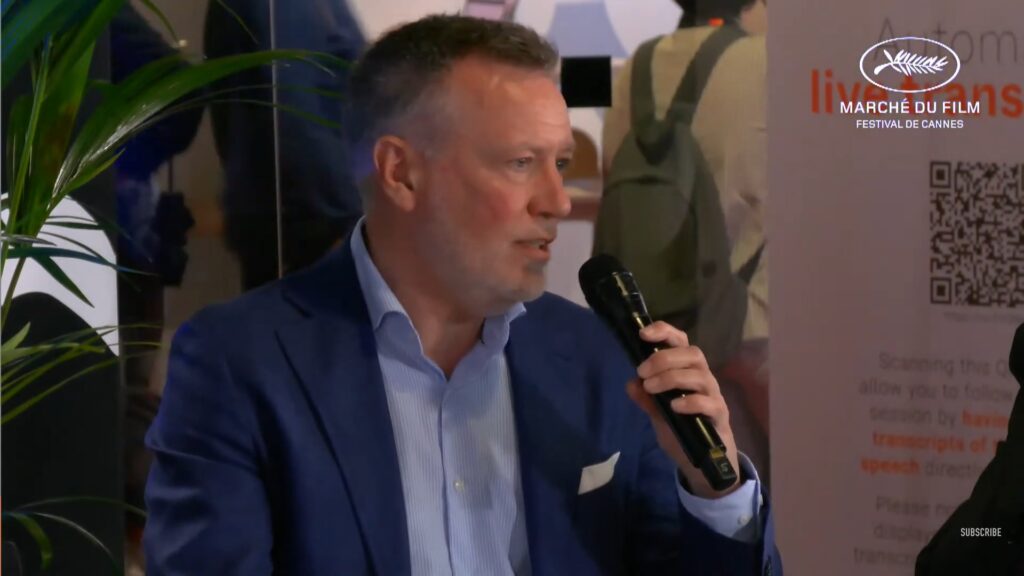
On May 20, Cannes’ Marché du film hosted its traditional morning conference, organized by the European Audiovisual Observatory (EAO). The second part of the event saw a panel discussion moderated by the EAO’s Head of Department for Market Information Gilles Fontaine. The conversation focused on the European box office crisis, and the most common problems producers, distributors and exhibitors are facing to attract audiences.
Speaking about the rather slow, post-pandemic recovery rate of Europe’s box office, Asger Flygare Bech-Thomsen, CEO of Nordisk Film Cinemas, argued that “what we are really missing are American blockbusters,” since “they are like a flywheel and provide big momentum for cinema-going,” he observed. “That is because blockbuster attract a broad audience, who is then exposed to trailers and will actually explore more genres than the blockbusters. We need US blockbuster as a ‘locomotive’ to drive the whole attendance of all films in Europe.”
Laurent Dutoit, CEO of Switzerland’s Agora Films, said that we are lucky to have enough data sets available to understand cinema-going trends, as these are more difficult to find for other forms of entertainment including sports events. “We have no idea how many people are watching football games in European stadiums,” he mentioned as an example, adding that in Switzerland, however, last year cinema-goers were still nine million in comparison to football fans going to stadiums, accounting only for two million. He also opened up the problem of some festivals targeting more and more hardcore arthouse films – often publicly funded and not really in need of box office revenues – attracting too small segments, while distributors and exhibitors struggle to get titles that could appeal to a wider audience.

Next, producers Didar Domehri and Mariela Besuievsky spoke about the role of festivals. In particular, Besuievsky agreed with Dutoit’s take on how some festivals have lost – or at least weakened – their connection with the audience, and mentioned the “endemic” trend of creating talent development initiatives, pushing the making of films in line with their editorial policy with the prospect of including them in their future line-ups. Besuievsky added that not all festivals – including the big ones – have a significant impact on Spanish box office. For example, the hottest Cannes titles, with the exception of “As Bestas”, didn’t record impressive results last year.
On the topic of premium cinemas, Bech-Thomsen stressed on the importance of running profitable business, which is essential for investments. He added that in the Scandinavian market further investments have proven to lead to stronger attendance figures. “Cinema is an art that should target everyone. […] If you’ll keep on increasing the price, you’ll lose a huge part of the population. It’s good that there is more room for premium cinemas in every city, but you still need to have cinemas that accessible to anyone – middle-class, workers and those with lower incomes,” added Dutoit.
Later, Christopher P. Marcich, CEO of the Croatian Audiovisual Centre, highlighted the importance of data to help policymakers to make informed decisions at national and European level.

The mic was then handed to Tomas Eskilsson, Head of Strategy at Film i Väst, who was asked whether theaters need more public support to attract and develop audiences. Eskilsson is in favor of such backing though its implementation should differ depending on the system and the stakeholders in place – in Sweden, for example, this type of support usually comes from municipalities. He noted how another crucial question the industry should discuss is whether it is worth to keep on producing and releasing more and more title without adequate capacity, thus affecting the quality of distributors and exhibitors’ promotion and curation activities.
Among other problems yet to be solved, Besuievsky highlighted the rise of confusing programming schedules (typically with titles popping in and out at random times) as well as the presence of shorter windows, which push people to see films on platforms at a later stage. She also pointed out the lack of press coverage for both industry reps and spectators. For example, she noted how there is less and less room for a “one-page interview with Ken Loach,” and many interesting news items “end up on the bottom of a page after just 24 hours.”
Despite the rise of the platforms, Dutoit stated how most of their distribution profits still comes from cinemas. However, he warned: “Once again, we lack some data on VoD. […] Getting these figures could be mandatory at European level. We always talk about theatrical figures, but when it comes to VoD we only talk about the offering, the number of films released, and we don’t have data on demand, [we don’t know] how many people really watch those films.”
- Moviegoers Return But Italian Cinema is Running Out of Stories, Say MIA Panellists - October 22, 2025
- Distribution Around the World: Buyers at TIFF Share Lessons for Theatrical’s Next Chapter - September 30, 2025
- Locarno Insights: Marketing Classics in the Age of Letterboxd - August 22, 2025